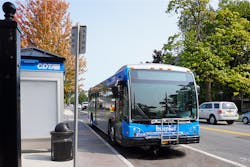CDTA's River Corridor BRT service connecting the region to opportunity
The Capital District Transportation Authority (CDTA) launched its second Bus Rapid Transit (BRT) along the River Corridor, making connections and service quicker and easier than ever before.
The service, which is known as the “Blue Line,” will connect communities along the Hudson River with limited stop service that looks and feels like rail service on wheels. It is the second leg of CDTA’s three-line BRT network.
“The Capital Region is a growing regional hub and home to state government, technological innovation, small businesses, universities and thriving communities,” said Carm Basile, CDTA CEO. “The diverse urban centers and corridors in our region need evolving transportation infrastructure to support their continued renaissance.The Bus Rapid Transit service and the introduction of the Blue Line is an innovative solution to help improve access throughout the region, while investing in our communities.”
Blue Line customers will enjoy fewer stops, faster service and more connections while traveling the 16-mile route between Waterford, Cohoes, Lansingburgh, Troy, Watervliet, Menands and Albany. In addition to the enhanced service, CDTA has made significant infrastructure improvements along the corridor to benefit transit customers, pedestrians, and motorists.
“The CDTA Board has implemented a progressive vision to bring new services to the Capital Region that will make our communities and people more connected than ever before,” said Jayme Lahut, CDTA Board chairman. "The Bus Rapid Transit service is a key milestone in advancing that vision. The launch of this service is a tremendous day for the residents in the cities and towns this line now serves.”
The River Corridor BRT is a $42-million project with a majority of the funding awarded by the Federal Transit Administration and the New York State Department of Transportation. This includes 31-paired stations, 20 branded vehicles, expansion of the Troy garage, reconstruction of intersections with improved pedestrian connections and technology enhancements to prioritize bus traffic.
"The more diversity in a region’s infrastructure to accommodate all modes of transportation, the more competitive a region can be,” said Marie Therese Dominguez, New York State Department of Transportation commissioner. “[New York] Gov. [Andrew] Cuomo’s wise investment in CDTA’s Bus Rapid Transit Blue Line will not only help Capital Region residents get to where they need to go quicker and more efficiently but help reduce the region’s carbon footprint by reducing the need for cars on the road. This is a true win-win for the Capital Region and the Department of Transportation is proud of the role we continue to play to move the region’s economy forward."
“Regional transportation systems around the country play a critical role providing access and mobility to the communities they serve,” said K. Jane Williams, FTA deputy administrator. “CDTA is an example of how transportation systems can utilize innovation to continue being an economic driver for the communities they serve. I congratulate CDTA on the expansion of the BRT service and look forward to the continued success of this innovative program.”
The River Corridor produces three million transit rides annually and is undergoing a revitalization with developments that need more service. The Blue Line services a dense, urban corridor that connects offices, universities, shopping centers, retail districts, and residential areas in the heart of the Capital Region.
The new line is color coded in silver and blue, making the corridor and the service very distinctive. New buses will travel along the corridor and they will be coordinated with local services.
